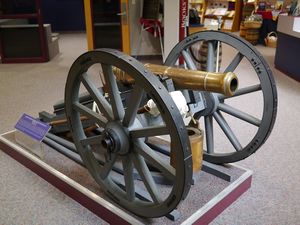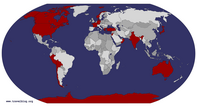Advertisement
Published: September 22nd 2012

 Cannon in the museum
Cannon in the museum
At Guilford CourthouseAfter a relaxing day and night doing nothing major, I left Richmond (Virginia) on Wednesday morning to head down south, into the Carolinas. My destination for the day was the site of the battle at Guilford Courthouse, which is near the modern city of Greensboro, North Carolina.
The drive south was pleasant, if long - 3 ½ hours. It was expressway the whole way, but it was quite nice scenery through leafy forests for the most part. I stopped at a couple of rest areas along the way to stretch my legs, but otherwise I headed straight to the National Park. Once again, there was a museum and short film in the Visitors Centre. Both were nicely done and gave a good overview of the battle. There was a second film presentation as well, this one concentrated solely on the tactics used in the battle.
The battle at Guilford Courthouse was about a year before the British surrendered at Yorktown, and was a big contribution to the British desire to head to Yorktown in the hopes of gaining reinforcements. American General Nathanial Greene had a small Continental Army which he supplemented with militia from North

 Battlefield
Battlefield
Guilford CourthouseCarolina and Virginia. His tactics for the battle were to have a defence in depth, so his army was deployed in three lines – the first two with militia who were told to fire two or three good shots before going home, and his final line of Continentals. The British took heavy losses from the militia, and were in real danger against the Continentals when Lord Cornwallis had his cannons fire canister shot into the melee, hitting troops from both sides. This callous move actually saved his troops (well, the ones that weren’t hit) and the Americans withdrew. Technically it was a British victory, but the American army was still intact and in parliament it was claimed “Another such victory would ruin the British Army” because they lost one quarter of their troops in the battle.
So I purchased the CD tour and proceeded to drive around the battlefield listening to it. It was quite well done, but probably not necessary if you watched the films and visited the museum. But still, the drive around the park was very nice. And the locals were out in force, walking and running around the park. Just as I was at the

 Battlefield
Battlefield
At Guilford Courthouselast stop, I got caught by one of the locals. Like most people I’ve met here, he really wants to visit Australia someday. But he proceeded to tell me a tale of a slave who fought at the battle, and while parts of his story sounded apocryphal and embellished (the basis of the story was in the film in the visitors centre so it wasn’t total bollocks), it was interesting nonetheless. He started to get me worried because the gates to the park close at 5pm and it was getting close and he wanted to keep talking. But I got out in time.
I then had an hour and a half drive to Charlotte, NC where I was staying the night. Here I hit what was really only my second hiccup for the trip – the hotel had no record of me being booked in. Luckily it was just on 9am back in Sydney so I rang my travel agent and she got it sorted out quick smart. I was soon in my room and had a peaceful night.
The next day (Thursday) I had two sites to visit. The first was just on

 Monument
Monument
At Guilford Courthouse battlefieldthe border of North and South Carolina – literally, as I crossed into South Carolina on the road to the park. It was the site of the battle of Kings Mountain. Again, there was a museum and film at the Visitors centre; again they were quite well done. The museum was a bit different though, as it was done as if it was within a forest. Each tree was a self-contained exhibit and audio presentation that activated when somebody entered.
The story of the battle of Kings Mountain was one of my favourites from the Revolutionary War. It didn’t feature the Continental Army, nor British regulars. It was Patriots vs Loyalists – all Americans except for the commander of the Loyalists. The British commander was a fellow named Ferguson, a Scottish officer who was an advocate of light infantry and guerrilla tactics, and even invented a rifle (the Ferguson rifle) that was one of the first to be breech-loaded. Ironically, it was such tactics that led to his defeat. The patriots consisted of local militia and so-called “Overmountain Men”, frontiersmen from Tennessee and Virginia. Despite the loyalists having a strong position on top of the mountain, the

 Encampment
Encampment
At Guilford Courthouse battlefield. There was no sign indicating what was going on here, but it had the look of a re-enactment group. Nobody was there though.rifles of the militia and overmountain men, not to mention their tactics of moving from tree to tree, gave them enough of an advantage to win the battle.
The next step for me was to visit the battlefield itself. This involved a 1.5 mile walking trail that went around the base of the mountain and then up to the top before heading back to the visitors centre. As far as I saw, I was the only one out on the trail at the time as I didn’t see another soul. But it was a fantastic walk through seemingly untouched forest, and very peaceful.
When the walk was over, I headed back to the car and drove onto my next destination – the battle of Cowpens. This was further into South Carolina and the landscape was changing. Unfortunately, it was not a change for the better. It was still pleasant enough, but I really enjoyed the scenery in Virginia and North Carolina. Once I arrived at the battlefield park, I headed to the visitors centre and while there was no museum, there was a film and another presentation that showed the tactics, but this time

 Trees
Trees
At Guilford Courthouse battlefieldwith a 3d map with led lights depicting the forces. There was a slight problem at one point when the narration spoke of the Americans falling back before turning and firing – the led’s that represented the troops didn’t move, but the musket firing appeared a hundred yards behind them. But technical hitch aside, it was pretty well done.
The tactics at Cowpens (named because cattle was taken there to feed before being taken to market in Charleston) were essentially the same as at Guilford Courthouse, but this time the militia didn’t go home and were able to return to the battle to complete a double-envelopment and the British were defeated. The battle actually occurred a couple of months before Guilford Courthouse, but different commanders were involved. The British commander Tarleton inspired the bad guy in Mel Gibson’s film “The Patriot”. The final battle of that film was a mixture of the battles at Cowpens and Guilford Courthouse.
I then went for a walk around the battlefield - a 1 mile trail took me to the key points. The scenery wasn’t as nice as the last two sites, but it was still pretty. When

 Monument of Nathaniel Greene
Monument of Nathaniel Greene
At Guilford Courthouse battlefieldI was done, I had a couple of hours drive to my hotel at Greenwood, SC. I chose it as a convenient location for my destination today (Friday). The city seems pretty poor, to be honest. I saw a shop advertising “$1 Fashion Jewellery” on my way into town, and laughed before I realised what I was laughing at - poverty. The hotel was pretty crappy, but across the road was a really nice Mexican restaurant.
This morning I headed out of Greenwood for a short drive to Ninety-Six. The original town of Ninety-Six was fortified by the British during the Revolutionary War and was the site of the first field battle in the south (in 1775, a couple of months after the events of Lexington and Concord), and the longest siege battle of the war (in 1781). Nathanial Greene besieged a small British force, but was unable to capture the star-fort that had been the main defence (there was also a stockade fort protecting the town). Again the Visitor Centre had a short film, which was well done. I did notice a couple of bits of footage from the film at Cowpens, and when I mentioned

 Ferguson Rifle
Ferguson Rifle
In the museum at Kings Mountainthis to the ranger he laughed and said they were made by the same company. I then headed out to the walking trail that went to the major sites. There was the American siege trenches (created by the Polish engineer Kosciuszko), the star fort, the old town of Ninety-Six, a reconstruction of the stockade fort and then a log cabin which is actually a restoration that had been moved to the park.
And that was the end of the revolutionary war sites I have planned to visit. It’s been pretty amazing visiting some of the most important sites of one of the most important events in world history - Boston, Lexington, Concord, Saratoga, Ticonderoga, Valley Forge, Trenton, Princeton, Philadelphia, Yorktown, Guilford Courthouse, Kings Mountain, Cowpens and finally Ninety-Six.
I left there and headed into Georgia. My overnight destination was Savannah, which is on the coast. However, my path took me through the city of Augusta so I had to stop there to see if I could find a souvenir for my Dad. For those that don’t know, the Augusta National Golf Course hosts the US Masters every year and is a bit of a

 Overmountain men's gear
Overmountain men's gear
In the museum at Kings Mountainholy site for golfers. Unfortunately it’s a very, very private and exclusive golf club and you can only buy genuine Augusta National souvenirs during the Masters, so I had to make do with a polo shirt that says “Augusta, Georgia”. Which should still make him happy. I also stopped quickly for a photo of what I think was the main entrance to the course. But I guess they figure that if you are able to visit, you should know where it is so there is no great big sign or anything. Or perhaps it was just the backdoor that I found. Anyway, I then had a few hours’ drive to Savannah so I got going.
Advertisement
Tot: 0.065s; Tpl: 0.014s; cc: 11; qc: 28; dbt: 0.0415s; 1; m:domysql w:travelblog (10.17.0.13); sld: 1;
; mem: 1.1mb























